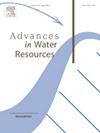动态模式分解四维成像数据,探索地下流动中的间歇性流体连通性
IF 4.2
2区 环境科学与生态学
Q1 WATER RESOURCES
引用次数: 0
摘要
非均质孔隙空间内多种流体的相互作用导致了复杂的孔隙尺度流动动力学,如间歇路径流动。同步加速器成像已被用来捕捉和分析这些动态。然而,这些成像数据集通常非常大(在tb数量级),很难提取相关流动现象的时空特征。因此,确定控制流体连通性的波动位置仍然是一个重大挑战。在这项工作中,提出了一种新的工作流,该工作流使用动态模式分解(DMD)来寻找表现间歇性流动动力学的关键时空区域。DMD是一种数据驱动的算法,它将复杂的非线性系统分解成占主导地位的时空结构,而不依赖于先前的系统假设。通过三个测试用例验证了该工作流程,每个测试用例在保持毛细管数恒定的情况下检查粘度比对流动动力学的影响。这些场景证明了DMD方法能够准确捕获底层流动行为,并从高维实验数据中提取关键的间歇结构。DMD为分析非均质孔隙空间中的复杂流体动力学提供了一种强大且计算效率高的方法。提出的工作流程能够快速客观地识别相关的时间尺度和感兴趣的空间区域。鉴于其速度和可扩展性,它作为分析大型同步加速器成像数据集的诊断工具具有强大的潜力。本文章由计算机程序翻译,如有差异,请以英文原文为准。
Dynamic Mode Decomposition of 4D imaging data to explore intermittent fluid connectivity in subsurface flows
The interaction of multiple fluids within a heterogeneous pore space gives rise to complex pore-scale flow dynamics, such as intermittent pathway flow. Synchrotron imaging has been employed to capture and analyze these dynamics. However, these imaging datasets are often extremely large (on the order of terabytes), and the spatial and temporal characteristics of the relevant flow phenomena are difficult to extract. As a result, identifying the locations of fluctuations that control fluid connectivity remains a significant challenge. In this work, a novel workflow is presented that uses Dynamic Mode Decomposition (DMD) to find critical spatio-temporal regions exhibiting intermittent flow dynamics. DMD is a data-driven algorithm that decomposes complex nonlinear systems into dominant spatio-temporal structures without relying on prior system assumptions.
The workflow is validated through three test cases, each examining the influence of viscosity ratio on flow dynamics while maintaining a constant capillary number. These scenarios demonstrate the capability of the DMD method to accurately capture underlying flow behavior and extract key intermittent structures from high-dimensional experimental data. DMD offers a powerful and computationally efficient approach for analyzing complex fluid dynamics in heterogeneous pore spaces. The proposed workflow enables rapid and objective identification of relevant time scales and spatial regions of interest. Given its speed and scalability, it holds strong potential as a diagnostic tool for the analysis of large synchrotron imaging datasets.
求助全文
通过发布文献求助,成功后即可免费获取论文全文。
去求助
来源期刊

Advances in Water Resources
环境科学-水资源
CiteScore
9.40
自引率
6.40%
发文量
171
审稿时长
36 days
期刊介绍:
Advances in Water Resources provides a forum for the presentation of fundamental scientific advances in the understanding of water resources systems. The scope of Advances in Water Resources includes any combination of theoretical, computational, and experimental approaches used to advance fundamental understanding of surface or subsurface water resources systems or the interaction of these systems with the atmosphere, geosphere, biosphere, and human societies. Manuscripts involving case studies that do not attempt to reach broader conclusions, research on engineering design, applied hydraulics, or water quality and treatment, as well as applications of existing knowledge that do not advance fundamental understanding of hydrological processes, are not appropriate for Advances in Water Resources.
Examples of appropriate topical areas that will be considered include the following:
• Surface and subsurface hydrology
• Hydrometeorology
• Environmental fluid dynamics
• Ecohydrology and ecohydrodynamics
• Multiphase transport phenomena in porous media
• Fluid flow and species transport and reaction processes
 求助内容:
求助内容: 应助结果提醒方式:
应助结果提醒方式:


